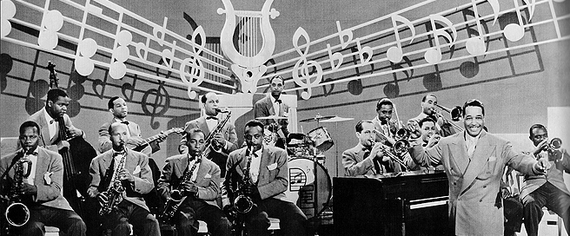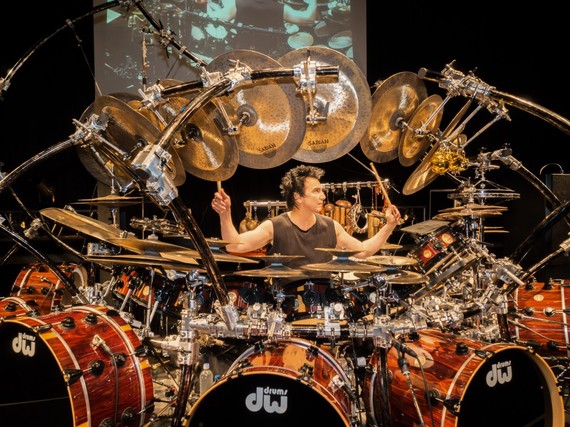This is the third in a series of articles on jazz musicians in popular music and jazz and popular music as fields of study in higher education.
Ghosts in the Machine, Part III: The Ghosts
In a recent essay in Commentary, Terry Teachout, arts and culture critic for the Wall Street Journal, makes an argument for the date on which the jazz era officially ended and the rock/pop era began-May 9, 1964, the last time a jazz musician (Louis Armstrong, with his version of "Hello Dolly," from the musical of the same name) topped the Billboard charts. As a point of demarcation, there is a lot to support this argument. (With all due respect to Armstrong, I would still point out that there were not many jazz musicians who would have cited "Hello Dolly" as a paragon of the style--clearly, to reach the charts at that late stage required tunes that were a far cry from most of the jazz from the 40s, 50s, and 60s that defined the era's "golden age." One could also argue that the jazz era ended a decade before, and that the nostalgic appeal of Armstrong's hit tune was itself evidence of that fact.) While these discussions are interesting, it really doesn't matter much. We know for a fact that at some point, the jazz era ended and the rock/pop era began, and like most cultural upheavals, it happened organically over a period of several years, after which the outcome was obvious and incontrovertible: jazz was out, and rock/pop was in.
Teachout's date for the end of one era and the beginning of another is a good one. This was indeed the last time that a jazz musician, as the leader of an ensemble, topped the popular music charts, but it was, by far, not the last time that a jazz musician would be found at the very top of the pop music world, albeit not as the leader of a group. Jazz musicians have been working in various genres of popular music from the beginning of the 20C. In fact, all of the popular music from the last 100 years is rooted in the blues and gospel music of the slave populations in the deep south. Jazz itself grew out of those simple folks music roots, and then, in turn, popular music (which, for purposes of this discussion, I define as "anything other than classical music and jazz") grew out of those same traditions as they matured into the rhythm and blues, soul, and blues genres in the middle of the 20C. It was not, however, merely the musical elements (scales, chord progressions, rhythmic patterns, etc.) of jazz that formed the structural basis of popular music. The standard rhythm section found in virtually all popular music--bass, drums, guitar, keyboard--was firmly established by the jazz musicians of the 1930s and 1940s as the ensemble perfectly suited, in terms of sonic capabilities, for the making of popular music, and that has not changed to this day, even though the styles have changed many times since then. Even the instruments themselves were modified and changed to accommodate the new styles. For example, there was no "drum kit" before the jazz era. Every drummer who sits on a stool (called a "drum throne" for obvious reasons!) with an array of drums and cymbals around him or her is utilizing what was first developed by the pioneering jazz drummers of the 1920s-30s.
Duke Ellington Orchestra, circa 1935
Terry Bozzio, circa 2010
The popular music since the 1960s is thus deeply indebted to the jazz, blues, and gospel music that preceded it. Those jazz musicians, however, did not disappear after the era lost its popular appeal; as the jazz era ended, many jazz musicians were looking for ways to practice their craft in the new environment in which they found themselves. The contributions of those jazz musicians to popular music are substantial and stunning--in fact, in some of the most artistically and commercially successful popular music of all time, we find jazz musicians in the foreground and in the background, in various roles, providing their expertise as performers, composers, arrangers, and producers. What follows is a brief, chronological survey, from the 1960s to the present day, of some of those contributions made by these ghosts in the pop machine.
~~~~~~~~~~~~~~~~~~~~~~~~~~~~~~~~~~~~~~~~~~~~~~~~~~~~~~
Jazz musicians have been featured as improvising soloists in many genres of popular music. Their improvisations often help to define the song, making it difficult to imagine without these masterful improvisatory contributions.
- The cadre of Detroit jazz and blues musicians, some of whom I was fortunate enough to know and work with, collectively known as the "Funk Brothers" provided the accompaniment for the Motown Music of the 1960s, which still enjoys widespread popularity. They brought an infectious jazz/blues infused rhythmic feel that added a great deal to the simple harmonic structures of the music. Here is one of those tunes, "My Girl," which was recorded at Hitsville Studios in Detroit by The Temptations in 1964, and quickly rose to the top of the Billboard charts.
1970s: Funk, R&B, Easy Listening, and Top 40
- Maurice White was the founder and leader of the phenomenally successful R&B/Funk horn band, Earth, Wind, and Fire. Prior to EWF, however, White was a well-established jazz drummer who performed with such luminaries as Sonny Stitt, Bunky Green, Ramsey Lewis, and others. White brought his subtle rhythmic sensibilities and his knowledge of jazz harmony to EWF and the result was a string of over a dozen Billboard Top 10 hits, with two reaching the top of the charts. Here is one of those number one hits, "Shining Star" followed by White performing "Song for My Father" from Ramsey Lewis' recording "Live in Tokyo." (Incidentally, the introduction for "Song for My Father," which was written by jazz pianist and composer, Horace Silver, was used by Steely Dan as the basis for their Top 10 hit from 1974, "Rikki Don't Lose That Number"!)
- Billy Joel's smash hit tune, "Just the Way You Are" from his 1977 recording entitled "The Stranger" features the renowned jazz saxophonist Phil Woods. Woods' improvisation is a melodic gem that adds a level of sophistication to a tune which, on its own, borders on the saccharine. Joel also featured another famous jazz musician, trumpeter Freddie Hubbard on "Zanzibar," from his 1978 album "52nd Street," after the famous street in New York City on which so many famous jazz clubs were found in the 1940s and '50s.
- 1977 was also the year that Steely Dan released their Grammy winning masterpiece "Aja." The album sold over five million copies, with two Top 40 hits, "Deacon Blues" and "Peg." "Aja" marks an artistic high point for the group and a financial success, a rare occurrence in any genre. Most notably, the album features two alumni from Miles Davis' groups from the 1960s--Wayne Shorter (tenor saxophone) plays a remarkable solo on the title track, and Victor Feldman (piano and percussion) is featured as well. The album also features many other famous jazz and studio musicians like Michael Brecker, Tom Scott, Pete Christlieb, and Larry Carlton, to name a few. "Aja" is, I think, the last time that popular music with such a strong jazz flavor was enjoyed such widespread success. It blends jazz and rock so seamlessly that neither genre is sacrificed to the other, and the result is a stunning achievement that stands in a league of its own--in 2010, it was inducted into the United States Recording Registry by the Library of Congress.
- Quincy Jones is a jazz trumpeter, composer, and arranger who performed with Dizzy Gillespie, Lionel Hampton and others. He was also featured as arranger for Sarah Vaughn, Dinah Washington, Count Basie, and Duke Ellington. He brought his formidable jazz knowledge and experience to his long-term collaboration with Michael Jackson as the producer of Jackson's three most popular recordings ("Off the Wall," "Thriller," and "Bad") that bestowed upon him the title "The King of Pop." The group of session musicians on these recordings includes, as is true with many pop recordings, many jazz musicians.
- Sting began his career working in jazz bands as a teenager, and in his solo work after The Police, he returned to that style, incorporating jazz elements overtly. His solo work was extremely successful and featured two younger jazz musicians of great renown, Branford Marsalis (saxophones), Kenny Kirkland (piano), and Omar Hakim (drums). As in the previous examples, it is impossible to imagine his work without the significant contributions of the many jazz musicians involved in these recordings.
- David Bowie, like Sting, grew up in the 1950s and his jazz proclivities are found in the foreground and background of his music from the beginning of his career in the 1960s until his death earlier this year. (For a more comprehensive discussion on Bowie's jazz influences, see my article following his passing earlier this year.) The use of saxophone or piano as a solo instrument in pop music is not uncommon, but in Bowie's music we find the use of both in ways that are quite surprising. In particular, there is a great deal of dissonant "free jazz" that brings an experimental flavor to so much of his music. What is even more surprising is that some of this music made it to the Top 10! Consider, for example, the atonal saxophone and trumpet improvisations in the background of his big hit "Let's Dance," which coexist happily with the Texas blues guitar of Stevie Ray Vaughn. (Jazz drummer Omar Hakim, mentioned above with Sting, is also featured.)
Jazz musicians are found throughout Bowie's career in various roles. Mike Garson, his long-time pianist and collaborator, is a jazz pianist who brought both traditional and avant garde jazz stylings to Bowie's music. On his album "Black Tie White Noise," Bowie features none other than the experimental "free jazz" trumpeter and founder of the Art Ensemble of Chicago, Lester Bowie.
It is thus interesting that for his final recording, "★" (pronounced "Blackstar"), he chose, for the first time, to use an extant group of jazz musicians, led by the outstanding saxophonist, Donny McCaslin, and also featured renowned jazz composer, Maria Schneider. It's not a jazz album by any stretch, but with these musicians collaborating and bringing their modern jazz aesthetic to Bowie's vision, it is strongly imbued with that flavor nonetheless.
~~~~~~~~~~~~~~~~~~~~~~~~~~~~~~~~~~~~~~~~~~~~~~~~~~~~~~
Pop music, like jazz, is composition by collaboration, an environment in which jazz musicians thrive. It should then be no surprise that jazz musicians are found so often in popular music of various kinds. Jazz is no longer a music that enjoys any kind of popular appeal, but clearly the rigorous demands of the music have created musicians with a powerful musical skill set that can easily transcend the confines of genre. This enormous versatility and flexibility has allowed jazz musicians to be able to easily and substantively contribute to other styles of music, which they have done and continue to do with spectacular artistry. The implications of these facts, in particular for our education system at all levels, will be discussed in the next installment in this series.
Special thanks to Wouter Turkenburg, whose essay on jazz ascomprehensive musicianship (IASJ Newsletter, Winter 2016) prompted this series.
Artwork by Katie Stockholm/Prosoundweb
Terry Bozzio photo by Erunobu Ohata, ClubCitta, Kawasaki



